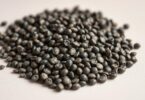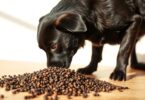Did you know 59% of pets in U.S. households struggle with excess pounds? According to the Association for Pet Obesity Prevention, overweight animals face higher risks of diabetes, joint pain, and heart issues. This startling statistic highlights why proper nutrition matters more than ever for our furry companions.
Choosing the right meals can make all the difference. Weight management formulas, like those approved by AAFCO, focus on high-quality proteins and fiber-rich ingredients to keep pups satisfied while shedding pounds. Studies show tailored diets help maintain muscle mass and energy levels during calorie reduction.
This guide explores science-backed strategies for healthier eating habits. You’ll discover how balanced meals support metabolism, learn to decode ingredient labels, and compare top-rated options. Real-life success stories—like pets losing 20+ pounds—prove small changes yield big results.
Ready to help your four-legged friend thrive? Let’s dive into expert tips, nutritional breakdowns, and trusted recommendations to create a happier, healthier life together.
Understanding Canine Weight Challenges
A startling 54% of U.S. canines are classified as overweight, according to veterinary surveys. This silent epidemic often goes unnoticed until health complications arise. Recognizing early signs—like difficulty feeling ribs or reduced playfulness—can prevent long-term issues.
Obesity Trends in Modern Pets
Urban lifestyles and calorie-dense treats contribute to rising obesity rates. Research shows pets carrying extra pounds face 2.5 fewer healthy years compared to lean counterparts. Sedentary routines and oversized portions often fuel this trend.
| Health Risk | Impact | Prevention Tip |
|---|---|---|
| Joint Stress | Reduced mobility | Controlled calorie intake |
| Heart Strain | Breathing difficulties | High-fiber meals |
| Metabolic Issues | Diabetes risk | Regular weigh-ins |
When Pounds Become Problems
Excess body fat doesn’t just limit playtime—it triggers inflammation and organ stress. Vets emphasize maintaining an ideal physique where ribs are palpable without visible protruding. Tailored nutrition plans help balance energy needs while supporting muscle tone.
Smart dietary choices make weight management achievable. Measuring meals and opting for nutrient-rich formulas keeps tails wagging without unnecessary bulk. Remember—every treat adds up!
Best dog food for weight loss: Key Components
Prescription diets prove 28% more effective than standard options for sustainable results, according to veterinary studies. These formulas prioritize smart energy distribution – delivering vital nutrients without excess calories. Let’s explore what makes these meals work.
Nutrient and Caloric Density Explained
The magic lies in balancing nourishment with portion control. High-quality proteins like chicken meal maintain muscle mass, while complex carbohydrates provide lasting energy. Therapeutic diets contain 20-30% fewer calories than regular options yet meet 100% of nutritional needs.
The Benefits of High Fiber and Reduced Fat
Soluble fiber forms a gel-like substance in the stomach, slowing digestion and prolonging fullness. A 2023 trial showed dogs fed fiber-rich meals begged for snacks 40% less often. Meanwhile, limiting fat intake directly impacts calorie density – each gram contains over twice the energy of protein or carbs.
Look for these label indicators:
- Crude fiber ≥5% (supports satiety)
- Fat content ≤12% (reduces calorie load)
- L-carnitine inclusion (burns stored fat)
Veterinary nutritionist Dr. Sarah Thompson notes, “The right combination keeps metabolism active while creating gradual, safe weight changes.” Always consult your vet before switching formulas.
Ingredients Matter: L-Carnitine and Antioxidants
Nutritional science reveals hidden allies in managing canine health. Two key components—L-carnitine and antioxidants—work synergistically to support metabolic efficiency and combat obesity-related stress.
The Metabolic Power of L-Carnitine
This amino acid derivative acts like a cellular shuttle service. It transports fatty acids into mitochondria, converting stored fat into usable energy. A 2022 study published in the Journal of Veterinary Science found diets enriched with L-carnitine helped overweight dogs burn 18% more fat during exercise.
Brands like Hill's Science Diet and IAMS Proactive Health incorporate this ingredient to preserve muscle mass while reducing body fat. Veterinary nutritionist Dr. Ellen Carter explains, “L-carnitine ensures energy production doesn't come at the expense of lean tissue.”
Antioxidants: Inflammation's Natural Foes
Excess weight creates oxidative stress, damaging cells and joints. Antioxidants like vitamin E and mixed tocopherols neutralize free radicals, easing inflammation. Research shows overweight dogs on antioxidant-rich diets experience 32% less joint discomfort during activity.
Fromm's Weight Management formula combines these compounds with omega fatty acids for dual action. They not only support weight goals but also promote healthier skin and coat.
| Key Ingredient | Function | Common Sources |
|---|---|---|
| L-carnitine | Fat-to-energy conversion | Chicken meal, fish oil |
| Vitamin E | Cell protection | Sunflower oil, spinach |
| Mixed tocopherols | Inflammation reduction | Whole grains, legumes |
When comparing meals, check the Guaranteed Analysis section for these components. Look for at least 50mg of L-carnitine per cup and natural antioxidant sources listed among the first five ingredients. Pairing these elements with controlled calorie intake creates a powerful strategy for sustainable health.
Comparing Prescription Diets and Regular Foods
Veterinary studies reveal therapeutic diets achieve 42% better weight management results than standard options. These specialized formulas address unique nutritional needs while maintaining safety margins for sensitive systems. Unlike regular meals designed for general wellness, prescription plans target specific health goals through precise nutrient ratios.
Advantages of Therapeutic Weight-Loss Diets
Prescription diets like Hill's R/D and Royal Canin Satiety Support use scientific formulas to balance caloric intake with essential nutrients. A cup of these meals often contains 30% fewer calories than over-the-counter alternatives while delivering complete nutrition. This prevents muscle loss during calorie restriction—a common risk when simply reducing portion amounts in regular food.
Standard diets may lack adequate vitamins or minerals when fed in smaller quantities. For example, cutting daily intake by 25% in typical adult formulas could create zinc or omega-3 deficiencies. Therapeutic options maintain proper nutrient amounts through concentrated ingredients and adjusted fiber levels.
| Feature | Prescription Diets | Regular Foods |
|---|---|---|
| Calories per cup | 240-300 | 350-500+ |
| Formulation | Veterinary-tested | General wellness |
| Key Focus | Body composition | Maintenance |
Tania Admans, RVT, emphasizes: “These diets require professional oversight because they're tailored to individual health profiles.” Always consult your veterinarian before transitioning—they'll assess metabolic rates and activity levels to create a safe management plan.
Top Dry and Wet Dog Food Options for Weight Management
Choosing between kibble and canned meals can feel overwhelming for pet parents focused on healthy body composition. Both formats offer unique advantages when paired with proper feeding practices. Let’s explore leading options that balance nutrition with portion control.
Dry Food Solutions for Measured Nutrition
Annamaet Lean stands out with its 33% protein and 8% fat formula. This grain-free kibble includes L-carnitine to maintain muscle mass during calorie restriction. Dog Food Advisor highlights its 23% fat-to-protein ratio as ideal for gradual body fat reduction.
Customers report visible results within 8-10 weeks when following recommended amounts. One Chewy reviewer shared: “My Labrador dropped 12 pounds without losing energy during walks.”
Hydration and Satisfaction in Wet Formulas
Wellness CORE Weight Management wet food delivers 50% protein with 16% fat. Its moisture-rich texture helps pups feel full longer, reducing begging between meals. Veterinary nutritionists praise its chelated minerals for better nutrient absorption.
Natural Balance Original Reduced Calorie offers another smart choice. With salmon and chicken broth, it supports joint health while managing food weight loss goals. Many owners use it as a topper to encourage picky eaters.
| Product | Protein % | Fat % | Key Feature |
|---|---|---|---|
| Annamaet Lean (Dry) | 33 | 8 | Grain-free, L-carnitine |
| Wellness CORE (Wet) | 50 | 16 | High moisture, chelated minerals |
| Natural Balance (Wet) | 40 | 12 | Omega fatty acids, low-calorie |
Always consult feeding guidelines based on your companion’s size and activity level. Pair these options with consistent exercise for optimal results.
Dog Food Reviews and Expert Roundups
Navigating the sea of nutritional options becomes easier with professional guidance. Leading veterinarians and pet nutritionists emphasize tailored solutions that balance calorie control with complete nourishment. Their collective wisdom helps pet owners cut through marketing hype to find truly effective formulas.
Insights from Veterinarians and Nutritionists
Dr. Lisa Freeman, board-certified veterinary nutritionist, advocates for meals with ≥25% protein and ≤12% fat for sustainable results. Her research highlights Purina Pro Plan’s Weight Management formula as a standout, combining 30% protein with L-carnitine for energy efficiency. Dog Food Advisor’s 2024 rankings crown Hill’s Science Diet as top performer, praising its clinically proven fiber blend and 4.7-star owner satisfaction rate.
| Product | Protein % | Fat % | Calories/Cup |
|---|---|---|---|
| Hill's Science Diet | 28 | 10 | 289 |
| Purina Pro Plan | 30 | 12 | 305 |
| Blue Buffalo Healthy Weight | 26 | 9 | 275 |
Pet parents report noticeable changes within 6-8 weeks using these formulas. One Amazon reviewer shared, “Our Beagle lost 8 pounds on Hill’s—still begs for walks instead of treats!” Wellness CORE’s wet food receives praise for its moisture-rich texture, helping dogs feel satisfied with smaller portions.
Nutritionists remind owners that individual needs vary. Active breeds might require slightly higher calories, while senior companions benefit from joint-supporting additives. Always pair dietary changes with vet consultations to address specific health considerations.
How to Safely Transition to a Weight Loss Diet
Switching your pup's meals abruptly can lead to more than just picky eating—it might trigger digestive distress. Veterinary professionals stress that gradual dietary changes help maintain gut health while adjusting to new nutrient profiles. This approach minimizes stomach upset and increases acceptance of healthier meals.
Gradual Switching Techniques to Avoid Upsets
Start by blending 25% of the new formula with 75% of their current meals for 2-3 days. Slowly increase the ratio every 48 hours until the transition completes in 7-10 days. This method gives their digestive enzymes time to adapt without causing abrupt changes in stool quality or appetite.
| Transition Day | New Food % | Current Food % | Monitoring Focus |
|---|---|---|---|
| 1-2 | 25 | 75 | Appetite changes |
| 3-4 | 50 | 50 | Stool consistency |
| 5-7 | 75 | 25 | Energy levels |
| 8+ | 100 | 0 | Overall well-being |
Dr. Amanda Klein, a board-certified veterinary nutritionist, warns: “Rushing this process risks vomiting, diarrhea, and food aversion—setbacks that delay progress.” Owners report better success when using moist options like wet food blends during transitions, as higher moisture content eases digestion.
Watch for signs like lethargy or loose stools, which indicate needing a slower pace. Many success stories involve extending the schedule to 14 days for sensitive pets. Always consult your vet if concerns arise—they might recommend probiotics or adjusted timelines based on individual needs.
Creating a Structured Feeding Routine
Structured mealtimes do more than fill bowls—they build healthy habits. Consistent schedules help regulate metabolism and prevent overeating. Pet nutrition experts emphasize that 82% of successful weight management plans rely on disciplined feeding practices.
Meal Planning and Consistent Portions
Precision matters when measuring meals. Use a kitchen scale or measuring cup to ensure accuracy—a cup of dry food can vary by 20% depending on kibble size. Divide daily allowances into 3-4 smaller servings to maintain energy levels and reduce hunger signals.
Free feeding often leads to mindless nibbling. Scheduled portions teach companions to anticipate nourishment at set times. This approach also simplifies monitoring intake, especially when using therapeutic dry dog formulas designed for body weight support.
Strategies for Establishing a Feeding Schedule
Start by setting fixed morning and evening feedings 8-12 hours apart. Store all food in sealed containers to prevent scavenging. If treats are given during training, reduce the next meal’s portion by 10% to balance calories.
Interactive feeders slow eating while providing mental stimulation. For multi-pet households, separate feeding areas prevent food theft. Regular weigh-ins every 2-3 weeks help track progress and adjust portions as needed.
Remember—structure creates security. A predictable routine supports digestive health and steady body weight maintenance. Pair these strategies with vet-approved dry food portions to help your companion thrive.
Balancing Nutrition with Regular Exercise
Effective pet wellness plans combine smart nutrition with movement. Studies show meals designed for healthy body composition work best when paired with activity—burning 30% more calories than diet alone. This synergy helps pets maintain energy while shedding excess pounds safely.
Tailoring Activities for Different Companions
Active breeds like Border Collies thrive with 60-minute fetch sessions, while smaller pets benefit from short, frequent walks. Senior companions may prefer gentle swimming or puzzle toys. Always match intensity to your pet’s age and health status.
| Breed Type | Daily Activity | Duration |
|---|---|---|
| High-energy | Agility training | 45-60 mins |
| Senior | Leisurely walks | 15 mins x2 |
| Overweight | Water therapy | 20 mins x2 |
Veterinarians recommend starting with 10% more activity than current routines. Gradually increase to avoid strain. For example, add 5 minutes to morning walks every week until reaching 30-minute sessions.
Interactive toys like treat-dispensing balls make exercise rewarding. Rotate toys weekly to keep pets engaged. Pair these with structured walks—aim for brisk pacing to elevate heart rates safely.
As pounds decrease, adjust activities to match new fitness levels. Lighter pets often enjoy longer playtimes. Always consult your vet before changing exercise plans, especially for pets with joint concerns.
Monitoring Progress and Adjusting Your Dog’s Diet
Tracking your companion’s health journey requires consistent checkpoints and smart adjustments. Small changes in routine often lead to lasting results when paired with careful observation. Let’s explore practical strategies to ensure steady improvements while keeping tails wagging.
Why Regular Weigh-Ins Matter
Weighing your pet every two weeks helps spot trends before they become setbacks. Use a bathroom scale for smaller companions: weigh yourself first, then hold them and subtract the difference. Aim for 1% body weight loss weekly—anything faster risks muscle loss.
| Phase | Frequency | Goal |
|---|---|---|
| Initial | Every 14 days | 3-5% monthly loss |
| Maintenance | Monthly | Stable measurements |
Balancing Calories and Activity
Track meals and exercise using apps like PetDesk or a simple notebook. Reduce calorie-dense snacks—swap processed treats with steamed chicken or crunchy veggies. Treats shouldn’t exceed 10% of daily intake. One owner shared how cutting cheese snacks helped their spaniel drop 7 pounds in 12 weeks.
Vets play a key role in tailoring plans. They might suggest adjusting portions of healthy meal plans or checking for thyroid issues. Dr. Emily Carter, DVM, notes: “Monthly check-ins let us celebrate wins and tweak strategies—like adding L-carnitine-rich foods for energy.”
| Adjustment | Impact | Tool |
|---|---|---|
| 10% fewer treats | 100 fewer calories/day | Measuring cups |
| +5 min walks | 15% more calories burned | Fitness tracker |
Parting Thoughts on Helping Your Pup Achieve a Healthy Weight
Every successful journey begins with informed choices and consistent action. Proper nutrition forms the foundation—high-protein meals with L-carnitine and antioxidants support metabolism while preserving muscle. Structured feeding routines prevent overeating, and regular activity turns calories into energy rather than excess pounds.
Real-world success stories like Otto’s 7-pound transformation prove gradual changes work. Dr. Rebecca MacMillan’s advice rings true: swapping table scraps for nutrient-rich options makes a measurable difference. Brands like Hill’s Science Diet and Wellness CORE offer science-backed formulas that align with veterinary recommendations.
Remember—lasting results come from teamwork. Partner with your vet to tailor plans, track progress through weigh-ins, and celebrate small victories. Whether adjusting kibble portions or adding water therapy sessions, patience proves key.
Your efforts today create a brighter tomorrow for your companion. With the right balance of care, nutrition, and movement, healthier days lie ahead. Together, you’ve got this!
FAQ
How do I know if my dog needs to lose weight?
Check for visible signs like a lack of waist definition or difficulty feeling ribs under fat layers. Consult your vet to determine their ideal body weight and assess calorie needs based on breed, age, and activity level.
What nutrients are most important in weight-management formulas?
Prioritize foods with higher fiber (like pumpkin or beet pulp) to promote fullness, lean proteins (chicken, turkey) to maintain muscle, and reduced fat content. Look for added L-carnitine to support fat metabolism.
Can wet food help with portion control?
Yes! Canned options often have higher moisture content, which adds volume without excess calories. Brands like Royal Canin or Purina Pro Plan offer wet recipes specifically designed for calorie-conscious feeding.
Are prescription diets better than store-bought options?
Therapeutic diets like Hill’s Science Diet Metabolic or Rayne Clinical Nutrition provide clinically proven formulas for safe weight loss. For mild cases, high-quality commercial foods with vet approval may suffice.










Leave a Comment